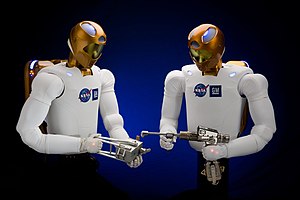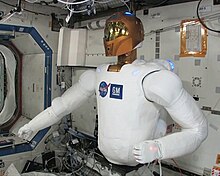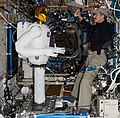Robonaut

Arobonautis ahumanoid robot,part of a development project conducted by the Dexterous Robotics Laboratory atNASA'sLyndon B. Johnson Space Center(JSC) inHouston,Texas.Robonaut differs from other current space-faring robots in that, while most current space robotic systems (such as robotic arms, cranes and exploration rovers) are designed to move large objects, Robonaut's tasks require more dexterity.
The core idea behind the Robonaut series is to have a humanoid machine work alongsideastronauts.Itsform factorand dexterity are designed such that Robonaut "is capable of performing all the tasks required of an EVA-suited crewmember."[1]
NASA states, "Robonauts are essential to NASA's future as we go beyondlow Earth orbit",[2]and R2 will provide performance data about how a robot may work side-by-side with astronauts.[3]
The latest Robonaut version, R2, was delivered to theInternational Space Station(ISS) bySTS-133in February 2011.[2]The first US-built robot on the ISS, R2 is a robotic torso designed to assist with crewEVAsand can hold tools used by the crew.[3]However, Robonaut 2 does not have adequate protection needed to exist outside the space station and enhancements and modifications would be required to allow it to move around the station's interior.[3]
As of 2018[update]NASA planned to return R2 for repairs and then relaunch.[needs update]
Robonaut 1
[edit]Robonaut 1 (R1)was the first model. The two Robonaut versions (R1A and R1B) had many partners includingDARPA.None were flown to space. Other designs for Robonaut propose uses forteleoperationon planetary surfaces, where Robonaut could explore a planetary surface while receiving instructions from orbiting astronauts above.[4]Robonaut B was introduced in 2002, R1B is a portable version of R1.[5]R1 had several lower bodies. One of these was the Zero-G Leg, which if Robonaut was working on the space station he would climb using the external handrails and then use his zero-g leg to latch onto the station using a WIF socket. Another was the Robotic Mobility Platform (RMP), developed in 2003,[6]it is a base with two wheels using aSegway PT.[7]And the four wheeled Centaur 1, which was developed in 2006.[8][9] Robonaut has participated in NASA'sDesert Research and Technology Studiesfield trials in the Arizona desert.[10]
In 2006, the automotive companyGeneral Motorsexpressed interest in the project and proposed to team up with NASA. In 2007 a Space Act Agreement was signed that allowed GM and NASA to work together on the next generation of Robonaut.[11]
-
Robonaut with zero-g leg
-
Robonaut attached to RMP
-
Robonaut attached to Centaur 1
Robonaut 2
[edit]
In February 2010,Robonaut 2 (R2)was revealed to the public. R2 is capable of speeds more than four times faster than R1, is more compact, more dexterous, and includes a deeper and wider range of sensing.[12]It can move its arms up to 2 m/s, has a 40 lb payload capacity, and its hands have a grasping force of roughly 5 lbs. per finger. There are over 350 sensors and 38PowerPCprocessors in the robot.[13]
Station crew members will be able to operate R2, as will controllers on the ground; both will do so usingtelepresence.One of the improvements over the previous Robonaut generation is that R2 does not need constant supervision. In anticipation of a future destination in which distance and time delays would make continuous management problematic, R2 was designed to be set to tasks and then carry them throughautonomouslywith periodic status checks.[11]While not all human range of motion and sensitivity has been duplicated, the robot's hand has 12degrees of freedomas well as 2 degrees of freedom in the wrist.[14]The R2 model also usestouch sensorsat the tips of its fingers.[15]
R2 was designed as a prototype to be used on Earth, but mission managers were impressed by R2 and chose to send it to the ISS.[11]Various upgrades were made to qualify it for use inside the station. The outer skin materials were exchanged to meet the station's flammability requirements, shielding was added to reduce electromagnetic interference, processors were upgraded to increase the robot's radiation tolerance, the original fans were replaced with quieter ones to accommodate the station's noise requirements, and the power system was rewired to run on the station's direct current system rather than the alternating current used on the ground.[11]

In the design of the R2 robot, a 3Dtime of flightimager will be used in conjunction with astereo camerapair to provide depth information and visible stereo images to the system. This allows the R2 to "see", which is one of the basic preconditions to fulfill its tasks. To integrate the various sensor data types in a single development environment, the image processing software Halcon 9.0 from MVTec Software (Munich, Germany[1]) is used.[16]
2011 Testing at the ISS
[edit]Robonaut 2 was launched onSTS-133on February 24, 2011, and delivered to theISS.On August 22, R2 was powered up for the first time while in low earth orbit.[17]This was called a "power soak" which is a power system test only with no movement. On October 13, R2 moved for the first time while in space.[18]The conditions aboard the space station provide a proving ground for robots to work shoulder to shoulder with people in microgravity. Once this has been demonstrated inside the station, software upgrades and lower bodies may be added, allowing R2 to move around the interior of the station and perform maintenance tasks, such as vacuuming or cleaning filters.[11]A pair of legs were delivered to the ISS onSpX-3in April 2014. The battery backpack was planned to be launched on a later flight in Summer/Fall 2014.[19][needs update]
Further upgrades could be added to allow R2 to work outside in the vacuum of space, where R2 could help spacewalkers perform repairs, make additions to the station or conduct scientific experiments. There were initially no plans to return the launched R2 to earth.[11]
2018 Repair and possible relaunch
[edit]NASA announced on 1 April 2018 that R2 would return to Earth in May 2018 with CRS-14 Dragon for repair and eventual relaunch in about a year's time.[20]As of 2018[update]NASA planned to return R2 for repairs and then relaunch.[needs update]
NASA's experience with R2 on the station will help them understand its capabilities for possible deep space missions.
-
R2 aboard ISS withDan Burbank
-
R2 attached to Centaur 2
-
R2 with proposed terrestrial legs
-
R2 with its 'climbing legs'
Project M (R2 on the moon)
[edit]In late 2009, a proposed mission calledProject Mwas announced byJohnson Space Centerthat, if it had been approved, would have had the objective of landing an R2 robot on the Moon within 1,000 days.[21][22]
See also
[edit]- List of NASA robots
- CIMON– Floating robot deployed on the ISS byAirbus
- Int-Ball– Floating camera robot deployed on the ISS byJAXA
- Justin (robot),a similar robot on Earth byDLR
- Kirobo,first fully humanoid robot astronaut
- FEDOR (robot)– Russian humanoid robot astronaut
References
[edit]- ^J. L. Rochlis; John-Paul Clarke; S. M. Goza. (2001)."SPACE STATION TELEROBOTICS: DESIGNING A HUMAN-ROBOT INTERFACE AIAA 2001-5110"(PDF).
- ^ab"Robonaut home page".Nasa.Retrieved27 May2011.
- ^abc"Robonaut Robonaut ISS Mission".NASA. Archived fromthe originalon 31 May 2011.Retrieved27 May2011.
- ^Wethington, Nicholos (December 3, 2007)."Future Mars Explorers Might Only See the Planet from Orbit".Universe Today.Retrieved12 August2009.
- ^Ambrose, Robert."Robonaut"(PDF).Johnson Space Center. Archived fromthe original(PDF)on 2011-07-21.
- ^"Mobile Manipulation using NASA's Robonaut"(PDF).International Conference on Robotics & Automation. April 2004. Archived fromthe original(PDF)on 2010-06-24.Retrieved26 June2011.
- ^Malik, Tariq (October 20, 2004)."Segway platform puts robots in motion".USA Today.Retrieved2010-11-01.
Segway's self-balancing robot platform takes up about 2 square feet and comes equipped with software and interface electronics necessary to receive, process and execute commands from an onboard robot payload.
- ^"Robonaut".NASA.Retrieved26 June2011.
- ^"Robonaut: Project M Whitepaper".NASA.Archived fromthe originalon 2010-05-27.
- ^Berger, Brian (November 27, 2006)."NASA auditions robots for lunar exploration".NBC News.Archived fromthe originalon March 26, 2014.Retrieved2011-06-24.
- ^abcdef"Robonaut 2: Fact Sheet"(PDF).NASA.Retrieved25 June2011.
- ^"Robonaut 2".NASA.Retrieved25 June2011.
- ^Joson, Imelda B.; Aguirre, Edwin L. (February 23, 2011)."NASA's First Robot Astronaut".Sky & Telescope.
- ^Lovchik, C.S.; Diftler, M.A. (1999).The Robonaut hand: a dexterous robot hand for space.IEEE International Conference on Robotics and Automation. Vol. 2. pp. 907–912.doi:10.1109/ROBOT.1999.772420.
- ^O'Malley, M.K.;Ambrose, R.O. (2003). "Haptic feedback applications for Robonaut".Industrial Robot.30(6): 531–542.doi:10.1108/01439910310506800.ISSN0143-991X.
- ^Kreutzer, Lutz (1 May 2012)."Vision Software Enables NASA Robonaut to See".Photonics Spectra.
- ^"Welcome Aboard Robonaut 2".NASA. 2011-09-19.Archivedfrom the original on 2021-12-12.Retrieved3 November2011.
- ^"First Movement of Robonaut 2 on ISS".NASA. 2011-11-02.Archivedfrom the original on 2021-12-12.Retrieved3 November2011.
- ^"Twitter- AstroRobonaut".NASA. 12 March 2014.Retrieved29 March2014.
- ^G., Chris (April 1, 2018)."Tweet from Managing Editor for NASA Spaceflight".
#Robonaut stopped powering up. Crew troubleshooted. Electrical fault present. Coming back on CRS-14 next month for repair. Should be relaunched in about a year to go back to ISS. #SpaceX #Falcon9 #Dragon #CRS14
- ^Atkinson, Nancy (5 February 2010)."Will NASA Send Robots to the Moon with" Project M? "".Universe Today.
- ^Chang, Kenneth (November 1, 2010)."At NASA, a Quiet Quest to Send a Humanoid Robot to the Moon".New York Times.Retrieved2010-11-01.
A humanoid dextrous robot — at least the top half — already exists: Robonaut 2, developed by NASA and General Motors, is packed on the shuttle Discovery, scheduled for liftoff on Wednesday.
Further reading
[edit]- R.O. Ambrose, H. Aldridge, R.S. Askew, R. Burridge, W. Bluethman, M.A. Diftler, C. Lovchik, D. Magruder, F. Rehnmark,ROBONAUT: NASA's Space HumanoidArchived2012-10-02 at theWayback Machine,IEEE Intelligent Systems Journal, Vol. 15,No. 4, pp. 57–63, July/Aug. 2000,doi:10.1109/5254.867913.
- M. A. Diftler, C. J. Culbert, and R.O. Ambrose, "Evolution of the NASA/DARPA Robonaut Control System,"inIEEE International Conf. Robotics Automation,pp. 2543–2548, 2003.
- G. Landis, "Teleoperation from Mars Orbit: A Proposal for Human Exploration,"Acta Astronautica, Vol. 61,No. 1, 59-65 (Jan. 2008); also paper IAC-04-IAA.3.7.2.05, 55th International Astronautical Federation Congress (2004). (A popular version isavailable from NASA.)
- J. L. Rochlis, John-Paul Clarke, S. M. Goza.SPACE STATION TELEROBOTICS: DESIGNING A HUMAN-ROBOT INTERFACEAIAA 2001-5110
External links
[edit]- Robonaut home page
- Robonaut2 NASA press release and fact sheet
- Robonaut2 GM press release
- Old Robonaut Website
- Robonaut 2 ready for International Space Station - April 14th, 2010Archived2013-11-02 at theWayback Machine
- In-depth article on Robonaut at NASASpaceFlight.com
- Robonaut: A Robotic Astronaut Assistant
- Robonaut 2 Overview slideshowArchived2016-07-31 at theWayback Machine







